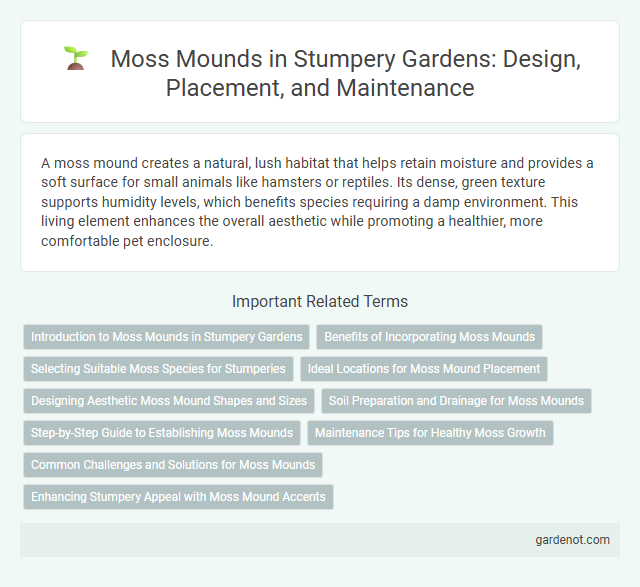A moss mound creates a natural, lush habitat that helps retain moisture and provides a soft surface for small animals like hamsters or reptiles. Its dense, green texture supports humidity levels, which benefits species requiring a damp environment. This living element enhances the overall aesthetic while promoting a healthier, more comfortable pet enclosure.
Introduction to Moss Mounds in Stumpery Gardens
Moss mounds in stumpery gardens create lush, textured landscapes by utilizing natural moss growth over decaying wood and stone. These mounds enhance moisture retention and provide a rich habitat for native biodiversity, promoting healthy micro-ecosystems. Incorporating moss mounds adds depth and timeless greenery, reflecting the ancient woodland aesthetic central to stumpery design.
Benefits of Incorporating Moss Mounds
Moss mounds enhance stumperies by providing natural erosion control and improving soil moisture retention, which supports diverse plant growth. Their dense texture creates microhabitats for insects and small wildlife, promoting biodiversity within garden ecosystems. Incorporating moss mounds also adds aesthetic depth through vibrant green hues and organic shapes, enriching the visual appeal of outdoor spaces.
Selecting Suitable Moss Species for Stumperies
Choosing suitable moss species for stumperies involves prioritizing varieties that thrive in shaded, moist environments, such as sheet moss (Hypnum spp.) and cushion moss (Leucobryum glaucum), known for their dense textures and vibrant green hues. These moss types enhance the visual appeal and naturalistic feel of stumpery designs while promoting biodiversity and moisture retention. Selecting species adapted to the local climate ensures sustainable growth and minimal maintenance in the stumpery ecosystem.
Ideal Locations for Moss Mound Placement
Moss mounds thrive in shaded, moist environments with consistent humidity, making woodland gardens and shaded rockeries ideal locations for their placement. Areas under dense tree canopies or near water features provide the cool, damp conditions essential for moss mound growth. Selecting sites with minimal direct sunlight reduces drying, ensuring the vibrant green aesthetic of moss mounds is maintained.
Designing Aesthetic Moss Mound Shapes and Sizes
Designing aesthetic moss mound shapes and sizes involves selecting varieties like sheet moss or cushion moss for texture contrast and visual appeal. Creating mounds with varying heights and gentle curves enhances naturalistic garden features, while incorporating stones or wood provides structural support and highlights the moss's lush greenery. Proper moisture management and shade ensure healthy growth, maintaining the vibrant, soft appearance essential to a stunning stumpery.
Soil Preparation and Drainage for Moss Mounds
Creating a thriving moss mound begins with soil preparation that emphasizes acidic, well-drained substrates rich in organic matter such as peat or leaf mold. Effective drainage is achieved by incorporating coarse sand or grit beneath the moss layer to prevent waterlogging while retaining adequate moisture levels. Ensuring a slightly shaded environment enhances moss growth by maintaining consistent humidity and cooler soil temperatures.
Step-by-Step Guide to Establishing Moss Mounds
Create a moss mound by selecting a shaded, moist location with acidic soil for optimal moss growth. Start by layering a base of organic material such as bark or wood chips, then gently press moss fragments onto the surface, ensuring good contact and moisture retention. Maintain consistent humidity and avoid direct sunlight to encourage moss establishment and long-term vitality.
Maintenance Tips for Healthy Moss Growth
Regularly mist moss mounds with water to maintain consistent moisture levels, avoiding direct sunlight that causes drying. Remove debris and fallen leaves promptly to prevent mold and fungal growth, ensuring adequate air circulation around the moss. Applying a light layer of acidic organic matter such as pine needles can help sustain the acidic soil conditions preferred by healthy moss growth.
Common Challenges and Solutions for Moss Mounds
Moss mounds often face challenges such as uneven moisture retention and insufficient light exposure, which can lead to patchy growth and discoloration. Ensuring consistent watering practices and positioning the mound in a shaded, humid environment promotes healthy moss development. Using a well-draining substrate mixed with organic matter prevents waterlogging and supports sustained moss vitality in stumpery designs.
Enhancing Stumpery Appeal with Moss Mound Accents
Moss mound accents elevate stumpery designs by introducing rich textures and vibrant green hues that complement aged wood and natural stone elements. These lush moss formations improve moisture retention, creating a thriving microenvironment ideal for shade-loving plants and fungi. Integrating moss mounds enhances the visual depth and organic appeal, transforming stumperies into captivating woodland-inspired landscapes.
Moss mound Infographic

 gardenot.com
gardenot.com